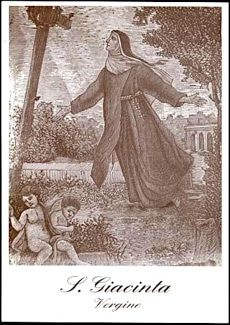 In her dreams there was a husband, not a monastery. Her name is Clarice. She is a beautiful young lady and is in love with a young marquis of the Capizucchi family. He is the ideal husband for the daughters of Marcantonio Marescotti, a prince of the high Roman aristocracy. The Prince in fact chooses to grant him one of his daughters as a bride-but it is not Clarice. It is Ortensia, the youngest one. Following this decision, Clarice becomes a terrible nuisance to the family, and is insufferable to all.
In her dreams there was a husband, not a monastery. Her name is Clarice. She is a beautiful young lady and is in love with a young marquis of the Capizucchi family. He is the ideal husband for the daughters of Marcantonio Marescotti, a prince of the high Roman aristocracy. The Prince in fact chooses to grant him one of his daughters as a bride-but it is not Clarice. It is Ortensia, the youngest one. Following this decision, Clarice becomes a terrible nuisance to the family, and is insufferable to all.
A similar disappointment would embitter anyone, but maybe the accusations were somewhat inflated to justify the father’s reaction, who in 1605 has her enter the San Bernardino Monastery in Viterbo with the Clarisses, where her sister Ginevra already is. Here she takes on the name Giacinta, but doesn’t become a nun: she chooses to be a Franciscan Tertiary, which doesn’t require the three-fold rule of complete poverty, celibacy, and obedience. She lives in two well-furnished rooms with her personal belongings and participates in the common activities. But she is not like the others. She knows it and the other nuns make her constantly aware of this: it is a difficult life for her. She continues that way of life for fifteen years: a life of “many vanities and foolishness in which I had lived in the sacred religion.” These were her later words.
In fact, there is a “later”. There is a profound interior transformation, after having gone through a serious illness as well as several deaths in her family. For sister Giacinta these events mark the beginning of twenty-four extraordinarily difficult years, in total poverty. And of continuous harsh penances, which would be difficult to comprehend today, but which reveal new and surprising energies.
From the two refined rooms she moves to a derelict cell to live in privation: but at the same time, it is from there that she achieves a singular “recovery”. People who are distant from faith gain it because of her, and become her collaborators in assisting the sick and the poor. Giacinta systematically requires this assistance of strongly motivated people on a regular basis.
This mysticism leads to the organization of institutes for assistance, as the one named “Sacconi” (from the “sac” which the brothers wear during their services). It was established to help the poor, the sick, and the prisoners, and will last until the 20th century. Along with the Sacconi, the Oblates were also established for serving the elderly.
The monastery in which Clarice entered as a disappointed and sullen young lady will see Giacinta fulfilled in a wholeness she never dreamed of. She will turn out to be a simulator of faith and a teacher: in fact we see her contrast the Jansenism present in her lands, with incisive stimuli to the Love and the Adoration of the Sacrament of the Eucharist. Not many people knew her in person. But after her death the entire town of Viterbo gathered at the Church where her body lay exposed. Everyone took a piece of her clothing, in fact she had to be clothed three times.
Clarice will remain in Viterbo forever, in the Church of the Clarice Monastery, which was destroyed during the war in 1940-1945 and rebuilt in 1959. Her canonization was celebrated by Pope Pius VII in 1807.
